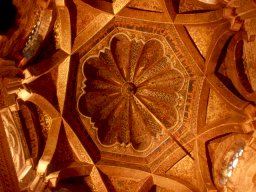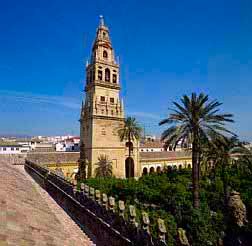
The Great Mosque of Cordoba (Spain) was considered a wonder of the medieval world by both Muslims and Christians. It is coined by many as the "Eighth wonder of the world" in its day.
Built on a Visigothic site, which was probably the site of an earlier Roman temple, the Great Mosque of Cordoba was begun between 784 and 786 (9th - 10th Century), in the Ummayyad era, during the reign of 'Abd al-Rahman I, who escaped from Syria to the Iberian Peninsula after his family was massacred by a rival political dynasty.
The mosque's hypostyle plan, consisting of a rectangular prayer hall and an enclosed courtyard, followed a tradition established in the Umayyad and Abbasid mosques of Syria and Iraq. As well as taking up Roman architectural traditions, the Cordoba masjid made use of older columns around, adding the Muslim sentiments of space, limitless rooms, light, and abstractness.
The bautiful arches, which the Cordoba masjid is famous for, are very representative of the general architecture dominating all over North Africa. The change between dark red and light white voussoirs adds beautiful simplicity, contrasted with the intricatly detailed ceilings (innder domes), where arabeseques are mixed with Arabic calligraphic writings.
It could be said that this beautiful masterpiece of Western Muslim architecture is spoilt by a Christian Cathedral cutting right into the masjid itself. The masjid no longer stands alone, but was transformed and turned into a Cathedral when the Christians took over. This issue will be looked at later.
The dramatic articulation of the interior of the prayer hall is unprecedented.
The system of columns supporting double arcades of piers and arches with the alternating red and white voussoirs is an unusual treatment that, structurally, combined striking visual effect with the practical advantage of providing greater height within the hall.
Alternating red and white voussoirs are associated with Umayyad monuments such as the Great Mosque of Damascus and the Dome of the Rock. Their use in the Great Mosque of Cordoba manages to create a stunningly original visual composition even as it emphasises 'Abd al-Rahman's connection to the established Umayyad tradition.
Though the masjid was expanded by later rulers (the most significant changes from the reigns of 'Abd al-Rahman II between 833-852, al-Hakam II between 961-976, and the vizier al-Mansur from 987), the basic formula of arcades with alternating voussoirs was maintained in each of the additions.
The resulting vistas of columns and arcades that stretch into the dim recesses of the prayer hall create a mysterious space that is often described as a forest of stone. The comparison is heightened by rows of trees planted in the courtyard (Patio de las Naranjas or Court of the Oranges), which create a visual continuation of the rows of columns within the prayer hall.
The most lavish interior ornament is concentrated in the maqsura, the prayer space reserved for the ruler, which was commissioned by the caliph al-Hakam II. The maqsura is visually separated from the rest of the prayer hall by screens formed of elaborate intersecting polylobed arcades, an elegant variation on the basic architectural theme set in the earliest incarnation of the mosque. These screens emphasise the special status of the space, which is composed of three domed bays in front of the mihrab.
The mihrab was unprecedented for taking the form of an entire room rather than the traditional niche, and for being flanked by two rooms whose entrances are decorated with mosaics in a manner similar to that of the mihrab.
The maqsura is lavishly decorated with carved marble, stucco, and elaborate mosaics. These, executed in intricate vegetal scroll forms and Kufic inscriptions, frame the mihrab, the two doors which flank it, and also cover the interiors of the maqsura's three domes. The unusual arrangement of the maqsura space may be read on several levels. It may reflect the appropriation of a tri-apsidal arrangement found in local church architecture (though emptied in its new context of Christian connotations). It has also been interpreted as an ideologically charged iconographic evocation of the Mosque of the Prophet in Medina that served to underscore notions of Umayyad religious and political authority.
After conquering Cordoba in 1236, Ferdinand III king of Castile consecrated the Great Mosque as the city's cathedral. The Christian population of Cordoba used the former mosque with relatively minor changes for the next three hundred years.
In the early 16th century the Bishop and Canons of the cathedral proposed the construction of a new cathedral, and proposed to demolish the mosque in order to build it.
The opposition of the townspeople to the proposed destruction of the building led to the unprecedented decision, endorsed by the Holy Roman Emperor Charles V, to insert an entire Gothic "chapel" into the very heart of the former Great Mosque.
The result is an uneasy and controversial juxtaposition: the soaring forms of a Gothic cathedral rise from the very centre of the comparatively low, sprawling prayer hall whose architectural vocabulary is rooted in the forms of classical antiquity.
Sources:
Creswell, K.A.C.1989. "The Great Mosque of Cordova." A short account of early Muslim architecture, revised edition by James W. Allan. Aldershot: Scolar Press.
Dodds, Jerrilynn. 1992. "The Great Mosque of Cordoba." al-Andalus : the art of Islamic Spain. Edited by Jerrilynn D. Dodds. New York: Abrams,11-26.
Ettinghausen, Richard and Oleg Grabar. 1987. The Art and Architecture of Islam: 650-1250. London and N.Y.: Penguin, 127-140.
Khoury, Nuha. 1996. "The meaning of the Great Mosque of Cordoba in the tenth century. " Muqarnas 13, 80-98.
[Mainpage] [Mosque] [Dhikr] [Du'a] [Prayer] [Health] [Games] [Tafakkur] [Asma al-Husna]

 The most lavish interior ornament is concentrated in the maqsura, the prayer space reserved for the ruler, which was commissioned by the caliph al-Hakam II. The maqsura is visually separated from the rest of the prayer hall by screens formed of elaborate intersecting polylobed arcades, an elegant variation on the basic architectural theme set in the earliest incarnation of the mosque. These screens emphasise the special status of the space, which is composed of three domed bays in front of the mihrab.
The most lavish interior ornament is concentrated in the maqsura, the prayer space reserved for the ruler, which was commissioned by the caliph al-Hakam II. The maqsura is visually separated from the rest of the prayer hall by screens formed of elaborate intersecting polylobed arcades, an elegant variation on the basic architectural theme set in the earliest incarnation of the mosque. These screens emphasise the special status of the space, which is composed of three domed bays in front of the mihrab.
 After conquering Cordoba in 1236, Ferdinand III king of Castile consecrated the Great Mosque as the city's cathedral. The Christian population of Cordoba used the former mosque with relatively minor changes for the next three hundred years.
After conquering Cordoba in 1236, Ferdinand III king of Castile consecrated the Great Mosque as the city's cathedral. The Christian population of Cordoba used the former mosque with relatively minor changes for the next three hundred years.